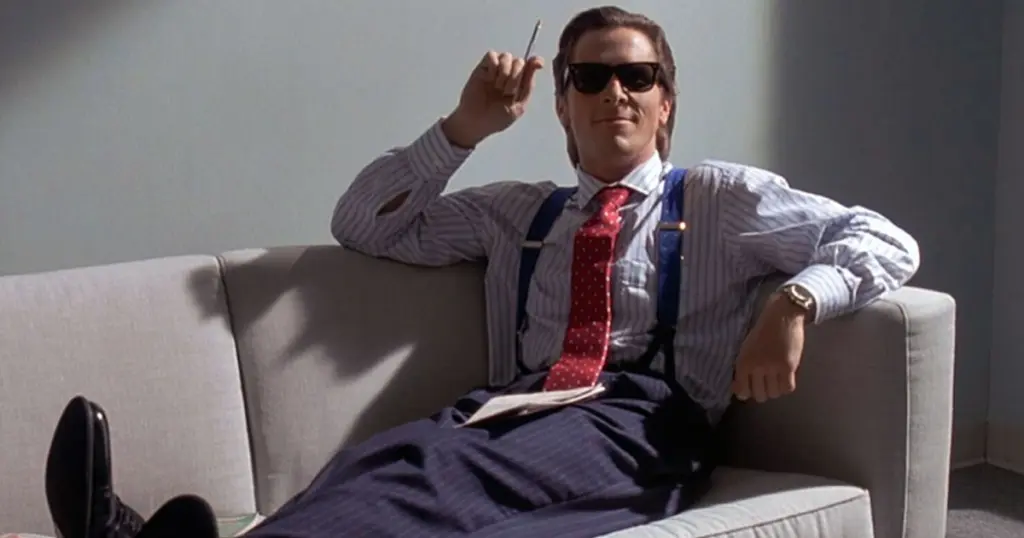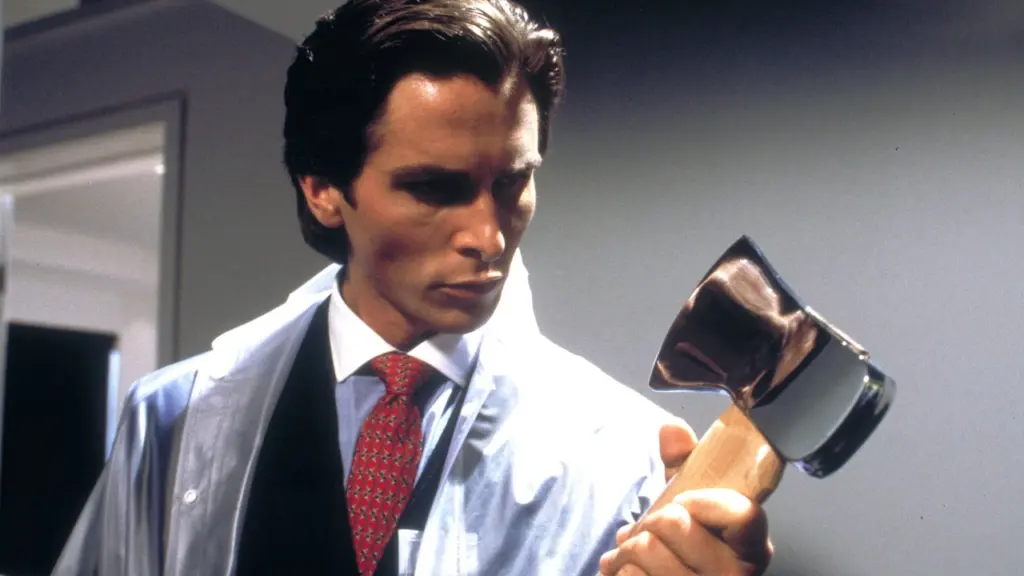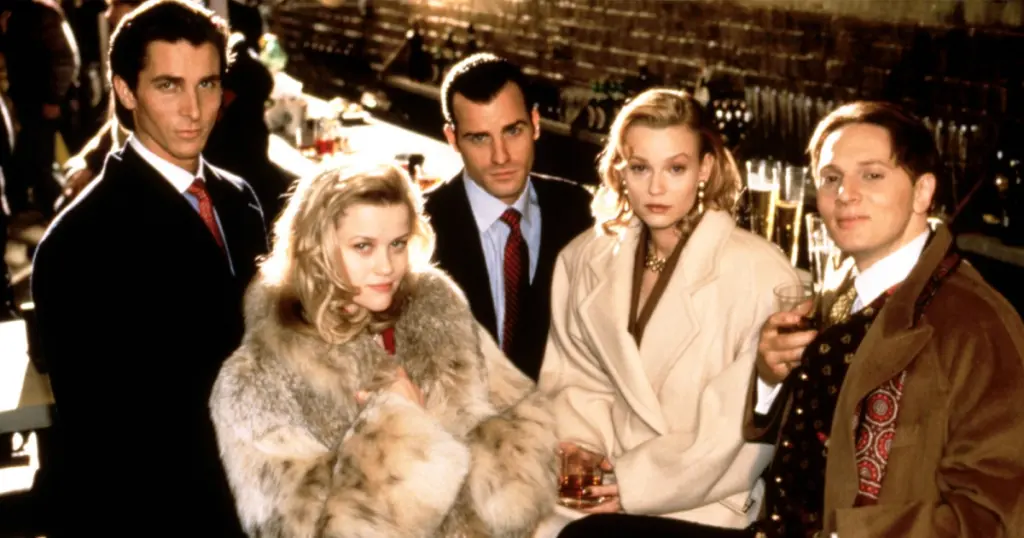The American Psycho episode of WTF Happened to This Adaptation? was Written and Narrated by Andrew Hatfield, Edited by Mike Conway, Produced by Lance Vlcek and John Fallon, and Executive Produced by Berge Garabedian. Here is the text of Hatfield’s script:
Horror can take many forms and its high time we talked about something firmly in the psychological realm. Author Brett Easton Ellis is known to broach subjects that are uncomfortable or outright horrifying, but it is with his 3rd book that he went for the throat so to speak and tackle a more traditional genre topic in a thoroughly nontraditional way. American Psycho was quite controversial upon its release in 1991 and the film based on it in 2000 (watch it HERE) was divisive then and it’s divisive now.
Take a look at the craftsmanship on that card as we find out what the f*ck happened to this adaptation.

The Movie
American Psycho is the 2000 adaptation of the novel of the same name from 1991 written by Brett Easton Ellis. This wasn’t the first adaptation of his work, and wouldn’t be the last, but both the movie and the novel have the strongest reputation out of his works. It was written by Mary Harron and Guinevere Turner and directed by Harron. Mary Harron had been a TV director mostly with episodes of Oz and Homicide: Life on the Streets under her belt as well as the indie movie I Shot Andy Warhol starring Lily Taylor and Jared Harris. She would mostly go back to TV after this movie but did direct the minor hit The Notorious Bettie Page. Turner has a more impressive acting resume than anything else but would go on to write some bigger projects like re-teaming with Harron for The Notorious Bettie Page and, hilariously, Bloodrayne which was adapted from the video game and directed by Uwe Boll.
The cast is an incredible collection of talent with Christian Bale in the title role of Patrick Bateman. Bale had already been a child actor with big roles in Empire of the Sun and Newsies but also had grown into himself as an actor with roles in Velvet Goldmine and Portrait of a Lady. This was all before he became an Oscar winner and Batman. Leonardo DiCaprio was actually talked out of taking this role and honestly, I think that’s for the best for everyone concerned. I love Leo, but this performance from Bale helps make the movie. While he is the driving force of the film, the supporting cast is full of big names like Reese Witherspoon, Jared Leto, Josh Lucas, Justin Theroux, Samantha Mathis, Cloe Sevigny, and Willem Defoe. The rights for the film were bought in 92 just a year after the book was published and directors that were considered were Stuart Gordon, David Cronenberg, and David Weiss. The duo that ended up making the movie started writing it in 1996.
Oliver Stone briefly took over but was let go after creative differences. Some of his decisions remained in the film but the script and tone remained after Harron was brought back in. Most of the filming took place in Toronto with some shots actually happening in New York. The cinemetographer often argued with Harron and it’s a miracle the film was made, particularly the way Harron wanted it to be. The shoot lasted 7 weeks and the movie made 34 million on its 7 million dollar budget. While that sounds like a pretty good ratio, the movie was ultimately considered a financial failure. Critically, the movie was divisive amongst critics with some like Peter Travers and Roger Ebert really enjoying it and seeing it’s value while others felt it was just a violent mess. Part of the reason it was considered a failure was because Lionsgate put a ton of money into the marketing, getting creative with things like a fake stock market game tie in to the movie and the ability to receive emails that were passed between characters in the film. It has become a cult hit, almost growing out of that label in fact, and had a cash in direct to video sequel in 2002 starring Mila Kunis.
The Book
American Psycho is the third book by author Brett Easton Ellis. His first book was published when he was only 21, called Less Than Zero, which was turned into a movie starring a young, weird science era Robert Downey Jr. in fact, more of his books have been turned into movies than not with Rules of Attraction and The Informers also being turned into big screen properties. He has 8 novels to his name with a couple others being in some form of production to be adapted to the big or small screen. He has also written for movies that aren’t based on his properties like The Canyons, The Curse of Downers Grove, and Smiley Face Killers. None of the movies, however, have had the impact or legs of American Psycho even 20 years on.
Ellis assumed that the book would be the end of his career due to overtly graphic violence found within. It has a mixture of boring banality and sudden or prolonged horror that creates a juxtaposition that can be hard for the brain to handle. It was censored or outright banned in parts of the world and had a very mixed reception upon release. Sadly, it also has an air of tragedy around it as it has been involved in a number of real-life terrors. It was found in possession of both Wade Frankum, who committed the Strathfield Massacre and Karla Homolka who was half of the Ken and Barbie killer’s duo. It was also said to have inspired the emails sent back and forth in the 2006 Duke Lacrosse team scandal, purportedly modeled after what Patrick Bateman would say. Regardless, its been a popular choice since it’s release and is easily Ellis’s best-selling novel.

What is the same?
Both book and movie follow a nearly identical chain of events. Patrick Bateman is a wall street investment banker in the late 80s who is shallow, status and wealth obsessed, and also a serial killer. He has a strict routine to take care of himself and hangs out with his guy group of equally terrible, though non-murdery, friends who comment on the looks and clothes of everyone they interact with while also being enveloped in sex, drugs, and excess. Bateman kills a coworker named Paul Owen who he despises for multiple reasons and spirals with further murderous rampages.
Bateman has a fiancé who he hates and constantly cheats on. He is grilled by a police detective who doesn’t really suspect much other than the coincidence of them working together. Bateman’s alibi checks out and he doesn’t get in trouble nor is he suspected in Paul’s murder. In fact, Paul may still be alive in London as he has supposedly been seen by a few people. Bateman continues to lose his grip and kills more and more people including a pair of women who he has known on occasion. He gets into a full-blown shootout and is chased by all manner of police but as it dies down, he is still not arrested or accused of anything. He calls his attorney and confesses all of the crimes he has committed via an answering machine before heading home.
He goes back to Paul’s apartment preparing to clean up the bodies but finds a clean and sterile apartment as well as a real estate agent who is upset at him for bursting in as she is trying to sell it. He freaks out again and begins to wonder what reality nobody is as believes him in terms of the crimes he has committed and there are no consequences whatsoever. He goes back to his lifestyle of sex, drugs, and excess and will probably kill again, if he ever killed in the first place.
The two mediums are remarkably similar right down to pieces of dialogue being used directly from the book into the movie. Most of the character names are the same too including Patrick, Paul, Evelyn, Detective Kimball, and his secretary Jean. His almost as horrible friends all share their book counterpart names and nearly every scene exists in both book and film, even if timelines are slightly different and rearranged in terms of conversations and order of events. Characters are constantly being confused for other characters or things are being mis heard or misinterpreted which gives everything an air of confusion. The tone of everything is almost the same too, even if details are changed in terms of hallucinations and actions. The ending of both is the same too as Patrick is allowed to continue his murderous and hedonistic ways and you aren’t sure if he is a reliable narrator or if he even committed these atrocities. However…

What Changed?
Well even though many things play out the same, the movie seems to be more in the camp of everything happening in the head of Patrick even if the filmmakers believe he is a serial killer. The book though has a scene that the movie doesn’t where a cab driver recognizes Patrick from not only a first-person account of another cab driver that he attacked but also an actual wanted poster. There is no reward, however, so he robs Bateman in a pretty neat turn where Bateman is finally the victim. The book also ends slightly differently with Bateman being less sorrowful like he is in the film and more existential like he may be trapped in his own personal hell.
Another major difference is the tone. At a relatively brisk hour and 41 minutes, the movie has very little down time. Even the times that Patrick is discussing everyday things like his self-care routine or music, its done in a brisk amount of time that flows with the scene. When he describes people or what they are wearing, it’s within the context of the scene we are watching and is a rapid-fire exchange, almost like the Howard Hawkes comedies of the 30s and 40s. in the book though it stops all flow. He goes on for pages and pages about his routine and the book takes multiple chapters to discuss entire artists and their albums.
At parties or gatherings, every item of clothing and jewelry is discussed and dissected at an absurd length and on tables every piece of food and ingredient are broken down in ways that would make some readers bored or even give up and move past the chapters or sections. These boring breakdowns make the explosive and often drawn-out acts of extreme violence even more shocking. The movie is undoubtedly graphic and horrifying, but the book takes the violence to levels that would be hard pressed to be put to celluloid. There are things that are virtually unfilmable and I’m not going to mention them here because I’d be bleeped so much that you’d think your sound output was broken.
The final differences are just minor ones like conversations in the movie being bulked into one scene that happen over a few encounters in the book or the depths to how insane Patrick is going. One of the more memorable scenes in the movie is when an ATM tells Patrick to feed it a cat while he holds a gun to its head. In the book he microwaves a jellyfish and witnesses a Cheerio being interviewed on TV amongst more than a few other absurd events that paint him losing his grip on reality. Like most books, its able to paint a bigger, and often more terrifying picture in its near 400 pages than the movie can.
Legacy
Both pieces are culturally relevant and beloved, but I’ll be honest, the movie is more frequently watchable than the book is readable. That took a lot for me to come to as the movie messed me up as a teen when I saw it the first time more than most movies have affected me during my lifetime. It was more disturbing than scary, and it really put me off horror for a few months, something that I find inconceivable now. Its incredibly written, shot, acted, and produced while keeping enough of the book’s scenes and ideas that if you’ve seen the movie, you’ve mostly read the book. Check out both and as always, let us know in the comments which you prefer.
A couple of the previous episodes of WTF Happened to This Adaptation? can be seen below. To see the other shows we have to offer, head over to the JoBlo Horror Originals YouTube channel – and subscribe while you’re there!
The post American Psycho (2000) – WTF Happened to This Adaptation? appeared first on JoBlo.
No comments:
Post a Comment